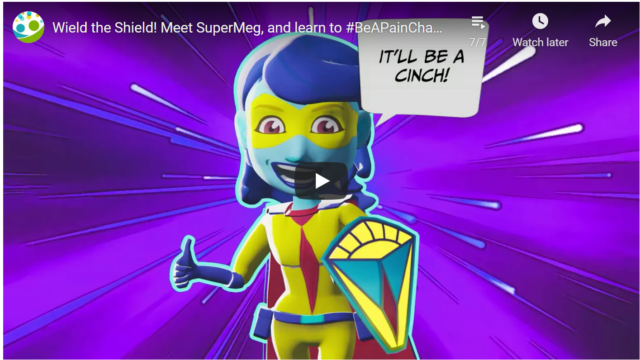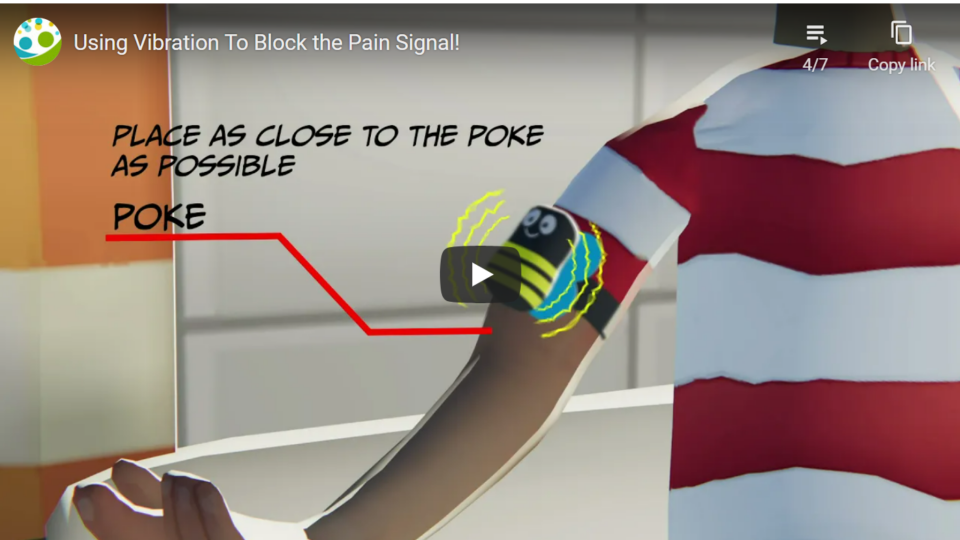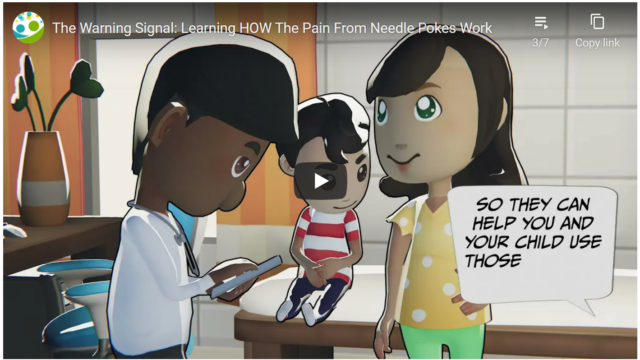How to Make Shots Hurt Less for Kids and Overcome Needle Phobia
Expert Strategies for Getting Your Child Through an Injection With More Comfort and Less Pain - Really!
Jamie Gentille, MPH, CCLS
Kids (3-11) Needle Pokes Procedural Pain English Pain Management
Share this:

Before You Read: We created a science-baked, interactive, walk-through guide on how to make shots not hurt for kids, led by our very own hero, SuperMeg! It includes videos, quizzes, and resources for you and your doctors. You can use this guide to plan for your next needle poke visit or while you are in a waiting room to make the experience more comfortable right away.
Expert Strategies for How to Help Shots Hurt Less for Kids and Overcome Needle Phobia
“Am I going to get a shot?” That’s the question that I asked my mom every time we had a doctor’s appointment. With having a congenital heart defect, in addition to contracting HIV from a blood transfusion as a child, my mom got that question A LOT.
Thankfully, my mom knew exactly how to answer that question, and how to support me when those appointments did involve needles. With hundreds and hundreds of injections, blood draws, IVs, and plenty of other needles on my resume, I’m here to tell you that you CAN make shots hurt less for kiddos. And it’s not just me – the Poke Princess – lots of research and best practice guidelines tell us that we have the power to make pokes better. Let’s talk about what you can do to help your kids through their immunizations.
It all starts before the actual doctor’s appointment. Do you think that professional athletes and performers pick up a ball or a mic for the first time on game day or opening night? No way!
Preparation: Helping Your Kid Feel More In Control About Needle Pokes
It all starts before the actual doctor’s appointment. Do you think that professional athletes and performers pick up a ball or a mic for the first time on game day or opening night? No way!
The prep work that goes into being successful in these events takes way longer than the event itself. The good news is – your poke prep-work isn’t that hard and pays off big time.
So let’s start there. Your child needs an immunization. You’re probably already feeling that pit in your stomach, and you wish that you could just do it for them.
You can’t do that, but guess what – you can do even better. You can equip them to get their immunization like a champ, and come away feeling proud and heroic…and confident they can handle any medical thing that comes their way!
With thee strategies you get to set the stage not only for this poke, and all the ones to come. So that investment of time and energy is WAY worth it. Follow these steps to learn how to make shots hurt less for kids.
Step 1: Help Your Child Understand the “Why” Behind the Poke
“Why?” “How come?” “What for?”
Do you get this a lot….like A LOT…..from your kids?
To the point where “because I said so” is pretty much your mantra? Turns out kids like to know why we have to do things, just like adults do, and it can really help motivate them and set the stage for a positive experience.
If you have to do something tough, there better be a good reason for it.
So start with that. Open with, “You know how we all have to do different things to keep our bodies healthy? Like eating, sleeping, brushing our teeth, taking medicine, and going to the doctor? It’s time for us to go see your doctor for a check-up, and to get some medicine to keep you healthy. Some medicines you can drink or chew, but for this check-up, this ‘stay healthy’ medicine will be through a poke.”
You’re being honest with your child, framing the WHY behind it, and introducing it in a gentle way.
It’s important to tell them that we all have to get pokes to stay healthy, and there are lots of things we can do to make it not so bad. (BTW, words matter! “Poke” is a great word to use instead of “shot,” which can already have some hard feelings that it brings up!). The next question will likely be something like “will it hurt?” Parents, this is your time to shine! It’s the question that we all dread, and you have the power to answer it like your kid’s own personal superhero. You can let them know how to make shots hurt less. Say something like “you might feel a poke/a pinch/a quick ouch, or you might not, but we are going to get through it together and do some things to make it feel a lot better.”
Overall, you want to cover:
- What it’s going to feel like (including the possibility it won’t bother them at all)
- How long it will last (VERY quick)
- What we can do to get through it
Step 2: Review Options for How to Manage Possible Needle Pain and How to Make Shots Hurt Less
During this prep time, you can also talk about tangible things to do for pain management. This could be numbing cream, Buzzy, Shotblocker, or Freezy spray, for example.
Watch this video that explains HOW pain works and the different ways we can control it. All of the different strategies that can help you feel more comfortable and in control when it comes to pokes and teaching them how to make shots hurt less will be a big help.
Pain Management Options to Make Shots Hurt Less
- Numbing cream is available over-the-counter at retail pharmacies, and is applied 30 minutes before the poke, to numb the skin.
- Buzzy is a small, vibrating device that you can use right at poke time. When you put this on the skin, it lets your brain feel the non-painful stimuli – the buzzing – instead of the painful stimuli – the poke.
- Shotblocker uses the same concept. It’s a small piece of plastic that has little nubs to confuse the nerves and take focus away from the poke itself.
- Freezy spray temporarily numbs the skin, and also works right away. It’s a vapocoolant that numbs the skin by making it super cold. Like Anna and Elsa cold.
Step 3: Make a Coping Plan to Combat Needle Fear and Anxiety
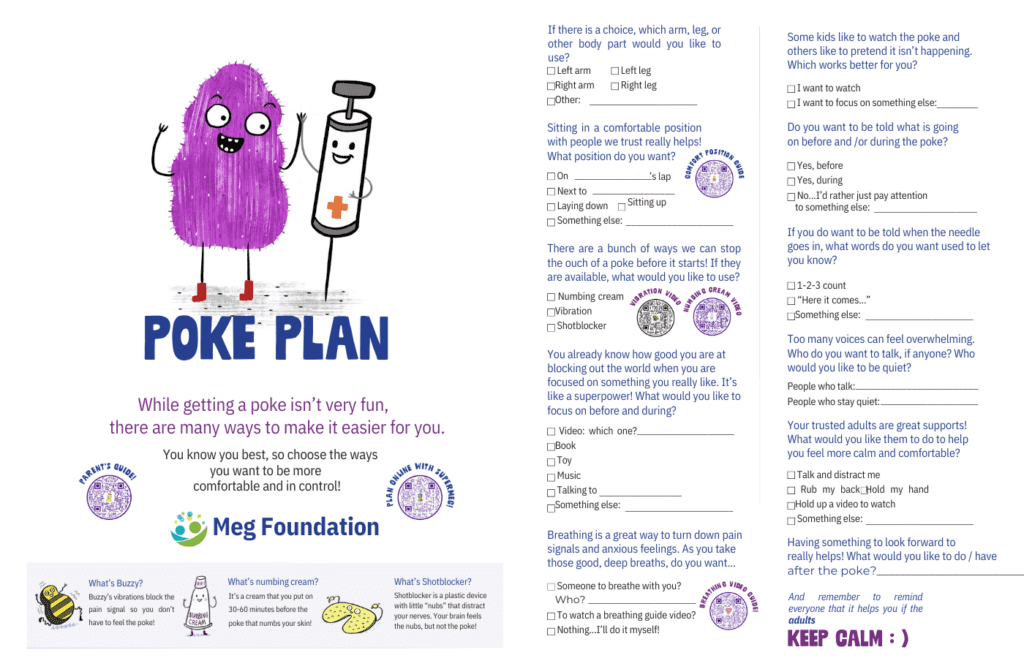
Let’s talk more about that coping plan, because that’s where your kiddo has some control. You can introduce all the things they can DO to help themselves.
Talk about a coping plan, and offer some options:
- “Do you want to watch or do you want to look away?”
- “Do you want to sit on my lap, or by yourself?”
- “Let’s pick something out to look at or play with during the poke.”
- “Would you like to take deep breaths, or count together?”
- “What would you like to do afterward to celebrate getting your poke?”
Talk about what they want to do, and PRACTICE it! This is your warm-up game.
Practice what position they want to be in, taking deep breaths, and any other coping technique that you decide on. Creating a personal plan is the key to know how to make shots hurt less for your individual child. Doing this in the comfort of your own home helps to hardwire it for actual go-time. Your kids may have questions throughout this talk, and you should answer them honestly and simply. If you don’t know the answer, it’s ok to say, “That’s a great question! I don’t know but I will try to find out” (and you can always reach out the Meg Foundation for answers).
For younger kids, you can also have a medical play set at home for them to play with. Adults talk through their feelings, but kids play them out. They can use play to explore the concept of getting pokes and going to the doctor. Just like dress rehearsal or scrimmage, this “prep talk” is key in setting your kiddo up for a successful immunization.
Older kids benefit from having this talk a few days before, while preschool age kids benefit from chatting a day or so before the appointment. And don’t be surprised if they get a little anxious or upset during this talk. That is totally normal, and even helpful. Better to get these feelings out now, when you aren’t actually getting the poke, than at the appointment. You’ll be able to address these concerns and get them back to baseline easier at home.
Step 4: Put Your Needle Poke Plan into Action!
Okay, it’s go-time!
The morning of the appointment, go through your coping plan, and get everything together that you might need.
Throw some extra things in your bag to keep your kiddo happy and content throughout the appointment. A favorite stuffy or toy is great, and now is a really good time to use that screen we usually are told to limit!
If you are using a numbing cream, apply it early to make shots hurt less when you get to the doctors!
Slap that stuff on before you get to the doctor’s office, so it has time to work. It works best when you rub a little bit completely into the skin, and then put a BIG GLOB on top. You’ll want to cover this with plastic wrap or the dressing provided in the package, so your kiddo doesn’t get numbing cream EVERYWHERE. It needs to stay right on the spot, not your couch/cup/cat.
If you have time, it’s a good idea to call the doctor’s office ahead of time.
Tell them about your child’s coping plan, so that they know what to expect too. Send them our provider tool kit, so they will know how to make shots hurt less before you even arrive.
If your child starts to get a little anxious at the office, that’s okay!
Let them know that having those feelings is normal, and remind them of all the different ways you both came up with to help those feelings. Answer their questions and reinforce their coping plan. Also reiterate that this is to help them stay healthy and that the people there are helpers. It can be tough, but resist apologizing for them having to get their immunizations. It’s a GOOD thing for them to do this to stay healthy. You can validate their feelings, while still framing it in a positive light.
Make sure the staff know what the coping plan is and how to facilitate it.
This is where you might need do a little advocating. Every once in a while, medical providers are nervous about kids sitting up in a comfort position for immunizations. Assure them that sitting up is research-backed, best practice recommended, proven-to-be-a-safe-and-effective way to give pokes with minimal distress. And then you’ll prove it to them!
Do not let any medical provider hold your child down.
Research demonstrates this can be very traumatic for kids (and not to mention totally unnecessary!).
But what if they cry, you ask? Guess what – crying is ok!
Tell them that it’s okay to have tears, and that they are doing a great job holding still/taking deep breaths/telling us what they are feeling. With pain management and this rock solid coping plan in place, though, you may see no tears at all! Kids always amaze us with how well they can get through things, and if things get upsetting, how well they bounce back.
Step 5: Celebrate and Validate Your Child’s Achievement (no matter how it went)
Now that you’re done, it’s time to CELEBRATE and VALIDATE!
Research shows how what we talk about after the poke can help determine their memory of what happened, and their expectations of the future!
Even if it didn’t go as smoothly as you may have hoped, focus on what went well…anything that went well/better than before!
Even if all you can muster is, “you did a great job not kicking/biting/fleeing the room like a wild banshee,” – success is success, even in its smallest form!
Ask if anything surprised them. If they think they should do anything different the next time to make it even easier and more comfortable. What they would tell other kids who have to get their pokes, to help them through it. How would they tell their friends about how to make shots hurt less?
And the fun part – follow through on the incentive! It can be as simple as getting an ice cream at a drive-through, or as extravagant as getting them their very own Shetland pony. (If you are going the pony route, I would like to come hang out at your house please). The important part is to celebrate them being a superhero with their immunization!
Immunizations no longer have to be pain in the butt – or arm – or leg.
You can make this a comfortable and positive experience for your kiddo by learning how to make shots hurt less!
You May Also Be Interested In
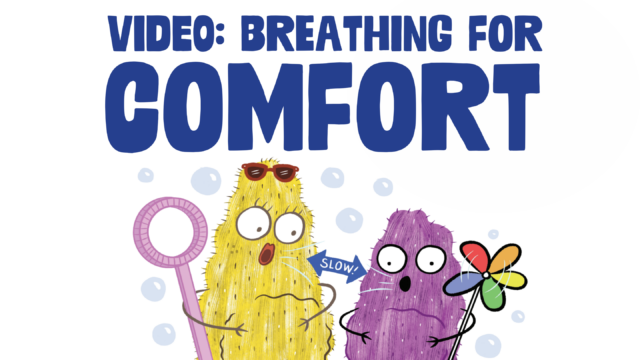
Video
Breathing for Comfort with SuperMeg!
Deep breathing is the ultimate hack of your nervous system. Discover how it can help you feel more calm and comfortable by letting Super Meg guide you to find that pace that is right for you.
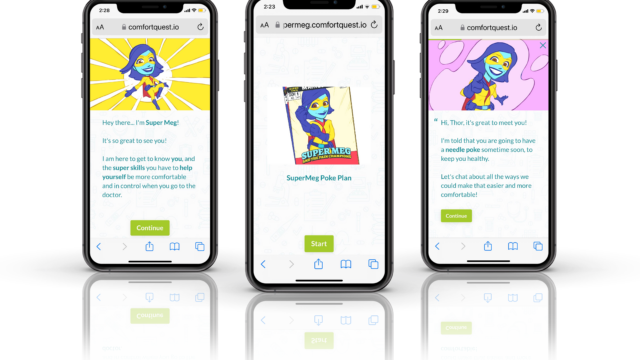
Digital Tool
SuperMeg Poke Planner
Have no fear, SuperMeg is here! This interactive tech helps your child create a plan for being more calm and comfortable during needle pokes.
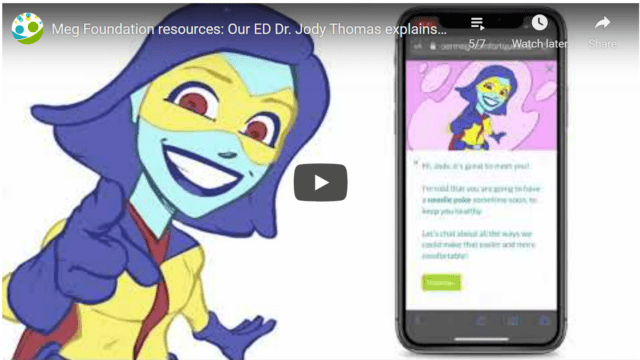
Video
Built to Empower: Pain Management Tools for All
Dr. Jody Thomas talks about how the Meg Foundation's freely available resources and tools are designed to empower kids, families, and adults to better manage their pain experience.

About the Author
Jamie Gentille received her BS in Biobehavioral Health from Penn State University and her Masters in Public Health from Walden University. She completed her Child Life internship at Children’s Hospital at Dartmouth and became a Certified Child Life Specialist in 2002. She is currently Director of Child Life Services at Inova Children’s Hospital, where she has worked since 2002. Jamie is also an adjunct professor at George Mason University. Jamie also serves as an Ambassador for the Elizabeth Glaser Pediatric AIDS Foundation. She has published a memoir, Surviving HIV: Growing Up a Secret and Being Positive, and is an accomplished speaker on the topic. Jamie lives in Northern Virginia with her husband and beloved dogs, Lucy and Pip.
